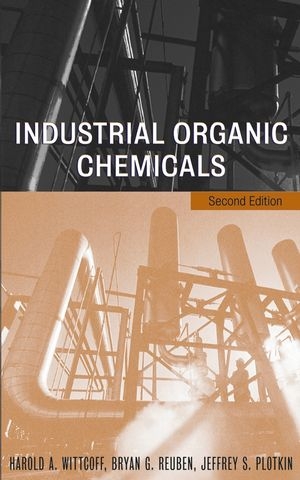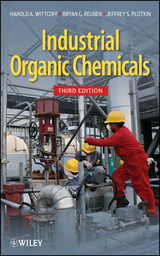
Industrial Organic Chemicals
John Wiley & Sons Inc (Verlag)
978-0-471-44385-8 (ISBN)
- Titel erscheint in neuer Auflage
- Artikel merken
This book broadly describes the essential topics of the organic chemicals industry. In the past two decades, the organic chemicals industry has undergone unprecedented restructuring, complicated feedstock problems, and massive shifts of capacity to developing countries. In the developed world, specialty chemicals have gained increasing significance. Although the fundamentals of organic chemical and polymer production have remained largely constant, one needs to be aware of the economic, structural, and political changes in the industry in order to understand its current state. This much-expanded "Second Edition of Industrial Organic Chemicals" presents the various technologies and processes involved in the organic chemicals industry as an organized body of knowledge.It describes the chemistry of the seven basic building block chemicals and their derivatives, how they are manufactured, their economic importance, uses, and associated environmental issues. Also covered are two topics essential to an understanding of modern industrial chemistry-catalysis and polymer synthesis.
Key additions to this Second Edition include discussion of: Sustainability and 'green' chemistry; dendrimers metallocenes chemicals in biotechnology; specialty chemicals for pharmaceuticals, electronics, fire retardation, fuel additives, foods, and other uses; and, economic, political, and social concepts for understanding future directions of the industry."Industrial Organic Chemicals, Second Edition" presents the chemistry of both large-scale and specialty products while taking into account important political, environmental, and economic considerations. It provides both a narrative account of the evolution of today's industry from the viewpoint of authors intimately involved with the changes, and an essential reference for chemists, chemical engineers, plastics engineers, petroleum engineers, managers, executives, and policy makers working in and with the organic chemical industry.
HAROLD A. WITTCOFF has taught industrial organic chemistry at the University of Minnesota while serving as Vice President of Corporate Research for General Mills, Inc. As scientific advisor to Nexant ChemSystems, he has presented 300 courses in industrial chemistry in twenty-eight countries. He is author/coauthor of 130 patents and sixty technical publications. BRYAN G. REUBEN is Professor Emeritus of Chemical Technology at London South Bank University. He has worked on the research and commercial sides of the Chemical Division of Distillers Company, Ltd. (now BP Chemicals), and was a founding member of both Surrey and London South Bank Universities. He is author/coauthor of about 130 publications and a single patent. JEFFREY S. PLOTKIN is Director of the Process Evaluation and Research Planning program at Nexant ChemSystems. He previously worked at Exxon Chemical and International Specialty Products (ISP) in both research and marketing positions. He is author/coauthor of about twenty-five technical publications and about thirty patents.
PREFACE.PREFACE TO THE FIRST EDITION.LIST OF ACRONYMS AND ABBREVIATIONS.CHAPTER 0 HOW TO USE INDUSTRIAL ORGANIC CHEMICALS, SECOND EDITION.0.1 Why this Book was Written and how it is Structured.0.2 North American Industry Classification.0.3 Units and Nomenclature.0.4 General Bibliography.0.4.1 Encyclopedias.0.4.2 Books.0.4.3 Journals.0.4.4 Patents.0.4.5 Statistics.0.4.6 CD-ROM and On-Line Databases.CHAPTER 1 THE CHEMICAL INDUSTRY.1.1 The National Economy.1.2 Size of the Chemical Industry.1.3 Characteristics of the Chemical Industry.1.3.1 Maturity.1.3.2 Participation in International Trade.1.3.3 Competition from Developing Countries.1.3.4 Capital Intensity and Economies of Scale.1.3.5 Criticality and Pervasiveness.1.3.6 Freedom of Market Entry.1.3.7 Strong Health and Safety Regulation.1.3.8 High Research and Development Expenditures.1.3.9 Dislocations.1.4 The Top Chemical Companies.1.5 The Top Chemicals.Notes and References.CHAPTER 2 CHEMICALS FROM NATURAL GAS AND PETROLEUM.2.1 Petroleum Distillation.2.2 Petroleum Refining Reactions.2.2.1 Steam Cracking.2.2.2 Catalytic Cracking.2.2.3 Catalytic Reforming.2.2.4 Oligomerization.2.2.5 Alkylation.2.2.6 Hydrotreating and Coking.2.2.7 Dehydrogenation.2.2.8 Isomerization.2.2.9 Metathesis.2.3 The Refinery-A Perspective.2.3.1 The Function of the Refinery and the Potential Petroleum Shortage.2.3.2 Unleaded Gasoline and the Clean Air Act.2.4 Separation of Natural Gas.Notes and References.CHAPTER 3 CHEMICALS AND POLYMERS FROM ETHYLENE.3.1 Ethylene Polymers.3.1.1 Discovery of Low- and High-Density Polyethylenes.3.1.2 Low-Density Polyethylene.3.1.3 High-Density Polyethylene.3.1.4 Linear Low-Density Polyethylene.3.1.5 Very High Molecular Weight Polyethylene.3.2 Ethylene Copolymers.3.2.1 Chlorosulfonated Polyethylene.3.2.2 Ethylene-Vinyl Acetate.3.2.3 Ionomers.3.2.4 Copolymer from "Incompatible" Polymer Blends.3.2.5 Ethylene-Propylene Elastomers.3.2.6 Ultra-Low-Density Polyethylene.3.2.7 Photodegradable Copolymers.3.3 Oligomerization.3.3.1 Dimerization.3.3.2 Ziegler Oligomerization of Ethylene.3.3.3 Other Ethylene Oligomerization Technologies.3.3.4 The Shell Higher Olefins Process (SHOP).3.4 Vinyl Chloride.3.5 Acetaldehyde.3.6 Vinyl Acetate.3.7 Ethylene Oxide.3.7.1 Ethylene Glycol.3.7.2 Proposed Non-Ethylene Oxide Processes for Ethylene Glycol Production.3.8 Styrene.3.9 Ethanol.3.10 Major Chemicals from Ethylene-A Summary.3.11 Lesser Volume Chemicals from Ethylene.3.11.1 Hydroformylation-Propionaldehyde, Propionic Acid, and n-Propanol.3.11.2 Ethyl Halides.3.11.3 Acetaldehyde Chemistry.3.11.4 Metal Complexes.3.11.5 Ethylenediamine and Related Compounds.3.11.6 Ethylene Oxide and Ethylene Glycol Derivatives.3.11.7 Vinyl Chloride and Ethylene Dichloride Derivatives.3.11.8 Vinyl Fluoride and Vinylidene Fluoride.3.11.9 Ethylene Dibromide.3.11.10 Ethanol Derivatives.3.11.11 Vinyl Esters and Ethers.Notes and References.CHAPTER 4 CHEMICALS AND POLYMERS FROM PROPYLENE.4.1 On-Purpose Propylene Production Technologies and Propane Dehydrogenation.4.2 Propylene via Deep Catalytic Cracking.4.3 Propylene via Olefin Metathesis.4.4 Propylene via Selective C4/C5 Cracking.4.5 Main Polymers and Chemicals from Propylene.4.5.1 Propylene Polymers and Copolymers.4.6 Oligomerization.4.7 Acrylic Acid.4.8 Acrylonitrile.4.8.1 Uses of Acrylonitrile.4.9 Cumene, Cumene Hydroperoxide, and Phenol.4.10 Acetone and Isopropanol.4.10.1 Methyl Methacrylate.4.10.2 Methyl Isobutyl Ketone and other Acetone Derivatives.4.11 Propylene Oxide.4.11.1 Propylene Oxide Applications.4.11.2 Projected Propylene Oxide-Propylene Glycol Processes.4.11.3 Other Novel Syntheses of Propylene Oxide.4.12 n-Butyraldehyde and Isobutyraldehyde.4.12.1 Uses for Butyraldehyde and Isobutyraldehyde.4.12.2 Other Oxo Products.4.13 Major Chemicals from Propylene-A Perspective.4.14 Lesser Volume Chemicals from Propylene.4.14.1 Allyl Chloride and Epichlorohydrin.4.14.2 Glycerol.4.14.3 Acrylamide.4.14.4 Acrolein.4.14.5 Acrylonitrile Derivatives.Notes and References.CHAPTER 5 CHEMICALS AND POLYMERS FROM THE C4 STREAM.5.1 Chemicals and Polymers from Butadiene.5.1.1 Acrylonitrile-Butadiene-Styrene Resins (ABS).5.1.2 Hexamethylenediamine.5.1.3 Lesser Volume Chemicals from Butadiene.5.2 Chemicals and Polymers from Isobutene.5.2.1 Methyl tert-butyl Ether.5.2.2 Butyl Rubber.5.2.3 Polyisobutenes and Isobutene Oligomers and Polymers.5.2.4 tert-Butanol.5.2.5 Methyl Methacrylate.5.2.6 Lesser Volume Chemicals from Isobutene.5.3 Chemicals and Polymers from 1- and 2-Butenes.5.4 Chemicals from n-Butane.5.4.1 Acetic Acid.5.4.2 Maleic Anhydride.Notes and References.CHAPTER 6 CHEMICALS AND POLYMERS FROM THE C5 STREAM.6.1 Separation of the C5 Stream.6.2 Isoprene.6.3 Cyclopentadiene and Dicyclopentadiene.6.4 Pentene-1 and Piperylene.Notes and References.CHAPTER 7 CHEMICALS AND POLYMERS FROM BENZENE.7.1 Phenol.7.1.1 Phenolic Resins.7.1.2 Bisphenol A.7.1.3 Cyclohexanone.7.1.4 Alkylphenols.7.1.5 Chlorinated Phenols.7.1.6 2,6-Xylenol and Cresols.7.1.7 Aniline from Phenol.7.2 Cyclohexane.7.2.1 Adipic Acid.7.2.2 Caprolactam.7.3 Aniline.7.3.1 4,4'-Diphenylmethane Diisocyanate (MDI).7.4 Alkylbenzenes.7.5 Maleic Anhydride.7.6 Chlorinated Benzenes.7.7 Dihydroxybenzenes.7.8 Anthraquinone.Notes and References.CHAPTER 8 CHEMICALS AND POLYMERS FROM TOLUENE.8.1 Hydrodealkylation and Disproportionation.8.2 Solvents.8.3 Dinitrotoluene and Toluene Diisocyanate.8.4 Lesser Volume Chemicals from Toluene.Notes and References.CHAPTER 9 CHEMICALS AND POLYMERS FROM XYLENES.9.1 o-Xylene and Phthalic Anhydride.9.1.1 Uses of Phthalic Anhydride.9.2 m-Xylene and Isophthalic Acid.9.2.1 Uses of Isophthalic Acid.9.3 p-Xylene and Terephthalic Acid-Dimethyl Terephthalate.9.3.1 Oxidation of p-Xylene.9.3.2 Alternate Sources for Terephthalic Acid.9.3.3 Poly(ethylene terephthalate).9.3.4 Lower Volume Polymers from Terephthalic Acid.9.4 Major Chemicals from Xylenes: A Summary.Notes and References.CHAPTER 10 CHEMICALS FROM METHANE.10.1 Hydrocyanic Acid.10.2 Halogenated Methanes.10.2.1 Chloromethane.10.2.2 Dichloromethane.10.2.3 Trichloromethane.10.2.4 Tetrachloromethane and Carbon Disulfide.10.2.5 Bromomethane.10.3 Acetylene.10.3.1 1,4-Butanediol.10.3.2 Lesser Uses for Acetylene.10.4 Synthesis Gas.10.4.1 Steam Reforming of Methane.10.4.2 Variants of Steam Reforming.10.4.3 Partial Oxidation of Hydrocarbons.10.4.4 Solid Feedstocks.10.4.5 Hydrogen.10.5 Chemicals from Synthesis Gas.10.5.1 Ammonia and Its Derivatives.10.5.2 Methanol.10.6 Carbon Monoxide Chemistry.10.6.1 Proposed Chemistry Based on Carbon Monoxide.10.7 Gas-to-Liquid Fuels.10.7.1 Sasol GTL Technology.10.7.2 Shell Middle Distillate Synthesis.10.7.3 Other GTL Technologies.Notes and References.CHAPTER 11 CHEMICALS FROM ALKANES.11.1 Functionalization of Methane.11.1.1 Methane to Methanol-Formaldehyde.11.1.2 Dimerization of Methane.11.1.3 Aromatization of Methane.11.2 Functionalization of C2-C4 Alkanes.11.2.1 Oxidation of C2-C4 Alkanes.11.2.2 Dehydrogenation of C2-C4 Alkanes.11.2.3 Aromatization of C2-C4 Alkanes.11.3 Carbon Black.Notes and References.CHAPTER 12 CHEMICALS FROM COAL.12.1 Chemicals from Coke Oven Distillate.12.2 The Fischer-Tropsch Reaction.12.3 Coal Hydrogenation.12.4 Substitute Natural Gas (SNG).12.5 Synthesis Gas Technology.12.6 Calcium Carbide.12.7 Coal and the Environment.Notes and References.CHAPTER 13 FATS AND OILS.13.1 Fatty Acids.13.2 Fatty Nitrogen Compounds.13.3 "Dimer" Acid.13.4 Aminoamides and Imidazolines.13.5 Azelaic, Pelargonic, and Petroselinic Acids.13.6 Fatty Alcohols.13.7 Epoxidized Oils.13.8 Ricinoleic Acid.13.9 Glycerol.13.10 Alcoholysis of Fats and Oils.13.10.1 Cocoa Butter.13.11 The Future of Fat and Oil Chemistry.13.11.1 Non-Caloric Fat-Like Substances.13.11.2 Alkyl Polyglycosides.13.11.3 Fatty Acid-Based Fuels and Lubricants.Notes and References.CHAPTER 14 CARBOHYDRATES.14.1 Sugars and Sorbitol.14.1.1 Furfural.14.2 Starch.14.3 Cellulose.14.4 Gums.14.5 Fermentation and Biotechnology.14.5.1 Amino Acids.14.5.2 Polymers.14.5.3 Proteins by Recombinant DNA Technology.14.5.4 A Fermentation Scenario.14.5.5 Can Ethanol Be Justified as a Fuel?Notes and References.CHAPTER 15 HOW POLYMERS ARE MADE.15.1 Polymerization.15.2 Functionality.15.3 Step- and Chain-Growth Polymerizations.15.3.1 Free Radical Polymerization.15.3.2 Chain Transfer.15.3.3 Copolymerization.15.3.4 Molecular Weight.15.3.5 Polymerization Procedures.15.3.6 Ionic Polymerization.15.3.7 Living Polymers.15.3.8 Block Copolymers.15.3.9 Graft Copolymers.15.3.10 Metal Complex Catalysts.15.3.11 Metal Oxide Catalysts.15.3.12 Metallocene and Other Single-Site Catalysts.15.4 Examples of Step Polymerization.15.4.1 Phenoplasts and Aminoplasts.15.4.2 Polyurethanes.15.4.3 Epoxy Resins.15.4.4 Dendritic and Hyperbranched Polymers.15.5 Polymer Properties.15.5.1 Crystallinity.15.5.2 Glass Transition Temperature, Crystalline Melting Point, and Softening Temperature.15.5.3 Molecular Cohesion.15.5.4 Stress-Strain Diagrams.15.6 Classes of Polymers.Notes and References.CHAPTER 16 INDUSTRIAL CATALYSIS.16.1 Catalyst Choice.16.1.1 Reaction Velocity and Selectivity.16.1.2 Recovery of Unchanged Catalyst.16.1.3 Catalyst Deactivation.16.1.4 Access to Nonequilibrium Products.16.2 Homogeneous and Heterogeneous Catalysis.16.2.1 Reactors for Heterogeneous Catalysts.16.2.2 "Immobilization" of Homogeneous Catalysts.16.3 Catalyst Markets.16.4 Catalysis by Acids and Bases.16.5 Dual Function Catalysis.16.6 Catalysis by Metals, Semiconductors, and Insulators.16.6.1 Catalysts for Automobile Emission Control.16.7 Coordination Catalysis.16.7.1 Catalysts for Stereoregular Compounds.16.7.2 Asymmetric Synthesis.16.8 Enzymes.16.8.1 Catalytic Antibodies.16.9 Shape-Selective Catalysts.16.10 Phase-Transfer and Fluorous Biphase Catalysis.16.11 Catalysts of the Future.16.11.1 Catalyst Design.16.11.2 Higher Selectivities.16.11.3 Catalysts with Greater Activity.16.11.4 Pollution Problems.16.11.5 Catalysts for New Reactions.16.11.6 Catalysts that Mimic Natural Catalysts.16.11.7 Catalyst Discovery via High Throughput Experimentation.Notes and References.CHAPTER 17 SUSTAINABILITY AND GREEN CHEMISTRY.17.1 Energy Sources.17.1.1 Wind Power.17.1.2 Wave Power.17.1.3 Solar Power.17.1.4 Methane Hydrate.17.1.5 The Hydrogen Economy.17.2 Pollution.17.2.1 The Ozone Layer.17.2.2 Global Warming.17.2.3 Trace Chemicals.17.2.4 Air Pollution.17.2.5 Water Treatment.17.2.6 Solid Wastes.17.2.7 Petrochemical Industry Wastes.17.2.8 Other Environmental Problems.17.3 Green Chemistry.17.3.1 The Decline in Acetylene Chemistry.17.3.2 Nylon.17.3.3 Replacement of Phosgene.17.3.4 Monomethylation by Dimethyl Carbonate.17.3.5 Liquid and Supercritical Carbon Dioxide and Water.17.3.6 Ionic Liquids.17.3.7 Photocatalysts.17.3.8 Paired Electrosynthesis.17.3.9 Sertraline Synthesis.17.3.10 Catalytic Dehydrogenation of Diethanolamine.17.3.11 Genetic Manipulation.17.3.12 Polyhydroxyalkanoates.17.4 Valediction.Notes and References.APPENDIX 1: A NOTE ON COST CALCULATIONS.APPENDIX 2: UNITS AND CONVERSION FACTORS.APPENDIX 3: SPECIAL UNITS IN THE CHEMICAL INDUSTRY.INDEX.
| Erscheint lt. Verlag | 23.7.2004 |
|---|---|
| Zusatzinfo | Illustrations |
| Verlagsort | New York |
| Sprache | englisch |
| Maße | 162 x 236 mm |
| Gewicht | 1053 g |
| Einbandart | gebunden |
| Themenwelt | Naturwissenschaften ► Chemie |
| ISBN-10 | 0-471-44385-9 / 0471443859 |
| ISBN-13 | 978-0-471-44385-8 / 9780471443858 |
| Zustand | Neuware |
| Haben Sie eine Frage zum Produkt? |
aus dem Bereich



